If you're visiting Florence, a stop at Palazzo Vecchio is a must. This majestic palace has been the city's town hall for centuries, and it's one of the most iconic landmarks in all of Italy.
Palazzo Vecchio overlooks the Piazza della Signoria, which is home to a copy of Michelangelo's world-famous David statue. The palace also has its own gallery of sculptures, the Loggia dei Lanzi, which is definitely worth a visit.
Whether you're interested in art, history, or just want to see one of Florence's most famous landmarks, Palazzo Vecchio is a great place to start your exploration of the city.
Palazzo Vechhio In A Nutshell
Palazzo Vechhio - Things to know
| ☀️ Best time to visit : | March to May (March-May) |
| ⏰ Suggested Duration: | Ideally, you will take 1 to 2 hours to walk around the entire Palace. |
| 🎟️ Palazzo Vechhio Ticket: | €17 |
| 📍 Location | Florence |
Palazzo Vechhio Opening Hours
October to March:
Thursday: 9 a.m. - 2 p.m.
All the other days: 9 am - 7 pm
April to September:
Thursday: 9 am - 2 pm
All the other days: 9 am - 11 pm
Must-see at Palazzo Vechhio
The Hall of Geographical Maps
Courtyards
Salone dei Cinquecento
The Arnolfo Tower
Palazzo Vechhio Address
Just a 1 min walk from Piazza della Signoria, 50122 Firenze FI, Italy
Get there
Why Visit Palazzo Vechhio
Palazzo Vecchio is one of the most popular tourist attractions in Florence, and for good reason. The Palazzo Vecchio is a magnificent example of Renaissance architecture, and its location in the heart of the city makes it easy to visit.The exterior of the Palazzo is adorned with statues by Michelangelo, Giorgio Vasari, and Donatello, and the interior is no less impressive.
You can see the secret routes throughout the Palazzo, including the private studio of Francesco I de' Medici, the former Grand Duke of Tuscany. The Palazzo Vecchio is truly a magnificent sight, and it's well worth a visit if you're interested in art and history.
Which Palazzo Vechhio Tickets Should You Buy?
Full of history and culture, the Palazzo Vecchio has a lot on its plate. Let us help you make the most of your visit! Here are two ways to pick your Palazzo Vecchio tickets to save your time:
Skip-the-line Palazzo Vecchio tickets
Being one of the most popular tourist destinations in Florence, it can be difficult to get inside during peak times. However, if you are willing to pay a little extra, you can skip the line and move straight into the Palazzo. This is an great option if you want to avoid the crowds and explore the Palazzo at your own pace. In addition, by skipping the line you will also have more time to enjoy the other attractions in the Palazzo, such as the gallery and the museum.
Combo Tickets
If you're interested in seeing more than just Palazzo Vecchio, you should take advantage of the combo tickets that are available. These combo tickets allow you to visit both Palazzo Vecchio and the Uffizi Gallery for only a few extra euros. The Uffizi Gallery is one of the most popular art museums in the world worth a visit. With combo tickets, you can save money and see some of the best that Florence has to offer.
History behind the Palazzo Vechhio
Palazzo Vecchio is a massive, imposing structure that sits in the heart of Florence. Built in 1299, it was constructed at a time when the city was undergoing great upheaval. The original Palazzo dei Fanti had been destroyed, and Palazzo dell'Esecutore di Giustizia was in ruins. The commune of Florence decided that they needed a new palace, one that would represent Florence at its best. They turned to Arnolfo di Cambio, the architect of the Duomo and Santa Croce church, to lead the project.
Cambio began construction on the Palazzo Vecchio using the existing foundations of Palazzo dei Fanti and Palazzo dell'Esecutore di Giustizia. After its construction, it served as the city's town hall for many years. However, in the 16th century, it was refurbished and became the residence of Cosimo I de Medici. Later, Cosimo moved to the Pitti Palace, and the Palazzo Vecchio was once again used as a government building.
Today, it houses a museum that is open to the public. Visitors can learn about the building's long history and see some of the incredible artwork that is on display.
Palazzo Vechhio Architecture & Design
Constructed between 1298 and 1314, the Palazzo Vecchio set the standards for Italian civic architecture during the 14th century. The palace was designed by Arnolfo di Cambio, the Italian sculpt,or and architect whose architectural style heavily reflects the transition from the late Gothic to Renaissance architecture. He designed the Palace as a cubical structure, made entirely of solid rusticated stonework. It has two rows of large Gothic windows, each with a trefoil arch. Featuring rusticated ashlar walls, the building was constructed of blocks of stone quarried from the local Boboli hillside.
The palace was later redesigned by Michelozzo in the 15th century. Using defensive architecture techniques to protect the palace, one of the most striking features of the building is the series of nine painted coats of arms of the Florentine republic, which are displayed in the spandrels between the trefoils. The building is also crowned with a projecting crenelated battlement, which adds to its imposing appearance.
The exterior of the building is decorated with bas-reliefs, paintings, and sculptures. The most notable feature is the Clock Tower, which stands over 100 feet tall and is adorned with a large clock face. Every hour, two bronze figures emerge from the tower and strike a bell.
The palace was later again redecorated by Michelozzo and Giorgio Vasari, in the late 16th century. The latter is attributed to reorganising and extensively working on much of the interiors of the Palace. The Palazzo Vecchio looms over the city like a sentinel and stands as a reminder of Florence's turbulent past and its enduring strength.
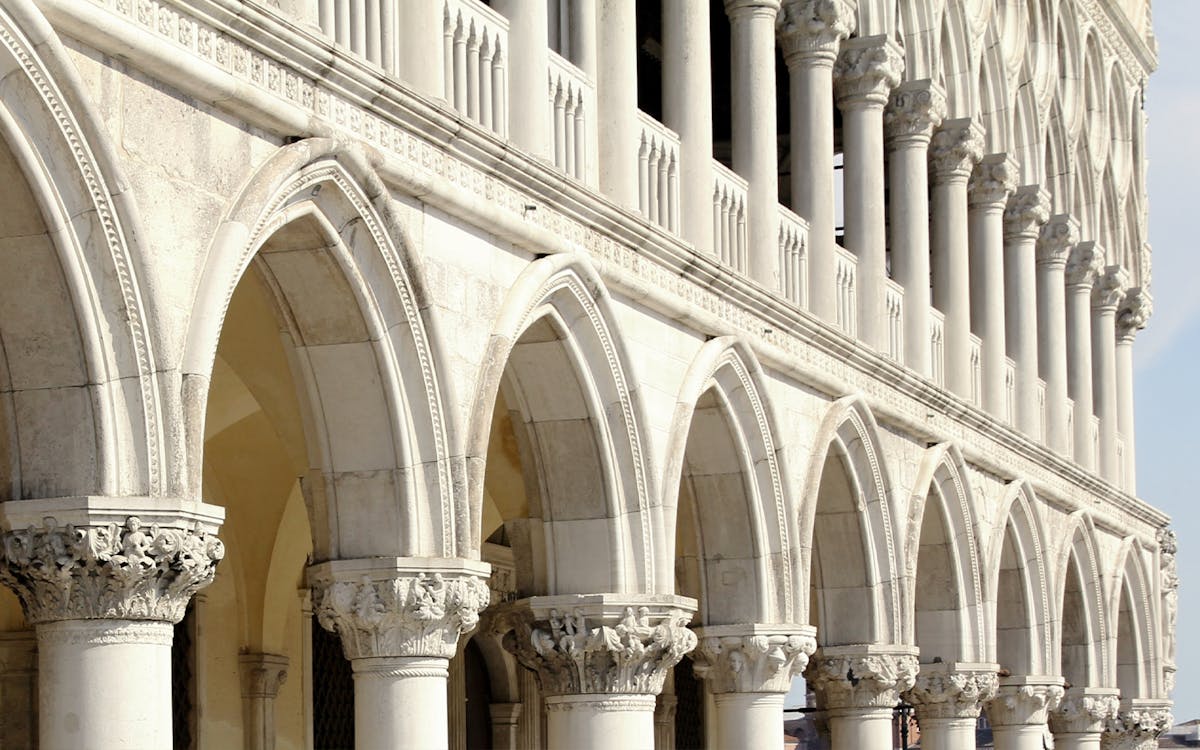
The tale behind the name
- In the 15th century, when it was known as the Palazzo della Signoria, as it overlooks the Piazza della Signoria.
- In the 16th century, the palace was used as the official residence of Cosimo I de’ Medici and was known as the Palazzo Ducale.
- Later when Cosimo I de' Medici moved to Palazzo Pitti, he officially renamed his former palace to the Palazzo Vecchio, the "Old Palace".
Top 5 things to see inside Palazzo Vecchio
1 Courtyards
Built in the 14th century, the First Courtyard was later modified by Michelazzo in the 15th century to replace the pillars with octagonal columns and loggia (a gallery with one side open to the garden). The walls of the courtyard depict the views of the major cities of the Habsburg (Austrian) Empire to pay homage to the Joan of Austria, including the cities of Linz, Vienna, Stein, Prague, Innsbruck and more.
At the center of the courtyard lies a fountain with a replica of Putto with Dolphin, renowned for its spiral design (with the original kept in the second floor). The courtyard displays grostesque decorations, stucco art, sculptures of marble and bronze, and more.
The Second Courtyard, also known as “La Dogana” or "The Customs", built in 1494 features massive pillars and the Marzocco weathercock, which once used to be on top of the Arnolfo tower.
The two monumental stairways by Giorgio Vasari with the access ramps to the upper floors of Palazzo Vecchio lies between these two courtyards.

2 Salone dei Cinquecento
One of the largest halls in Italy, the chamber is dedicated to showcasing the power and wealth of the Medici family. Originally commissioned by Girolamo Savonarola, the chamber was built by the Florentine architect Simone del Pollaiolo in 1494. Located on the first floor, the coffered ceiling with its intricate details and its 39 panels embedded with paintings of the victories of Florence and Medici’s life, offer insights into the history behind the Palace and of Italy in the past. The panels are home to frescos depicting Florence defeating its arch-rivals Pisa and Sienna, all painted by Giorgio Vasari and his helpers. The room also houses various sculptures, including that of Michelangelo's Genius of Victory.

3 Studiolo of Francesco I
To the side of Salone dei Cinquecento lies a small barrel-vaulted room, filled with paintings of mythologic or religious subjects. Translating to "little studio", the studio was commissioned by Francesco I de' Medici and designed by Giorgio Vasari and scholars Giovanni Batista Adriani, and Vincenzo Borghini. Just like a tinker lab, the room was where Francesco I studied alchemy and used the cupboards on the four walls to store his rare finds - stones, carved bones, forged metals and, more.
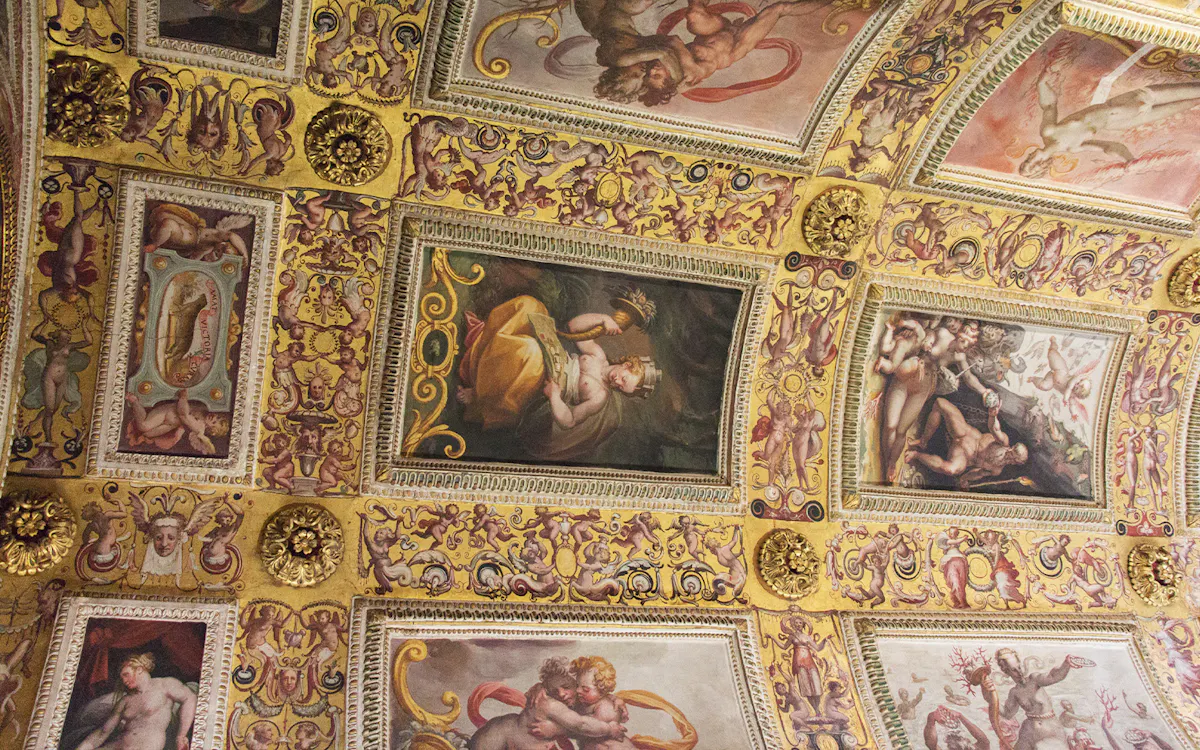
4 The Hall of Geographical Maps
The Hall of Geographical Maps or Guardaroba was an ambitious project of Giorgio Vasari, to display Cosimo’s collection of artifacts and cartography murals, all created with scientific instruments of that time. The Guardaroba was commissioned by Cosimo I de’ Medici during his major reconstruction of the interior of the Palazzo.
Though the room was never completed, the accounts of Giorgio Vasari, the room's designer, provide insight into the proposed purpose and visualization of the space. It is said that Vasari used a combination of mirrors and light cubes to create an immersive and realistic experience for viewers. Unfortunately, due to a variety of factors—including cost, political turmoil, and Cosimo's death—the Guardaroba was never completed. However, it provides an intriguing glimpse into the Renaissance understanding of geography and astronomy, and continues to inspire architects and designers to this day.
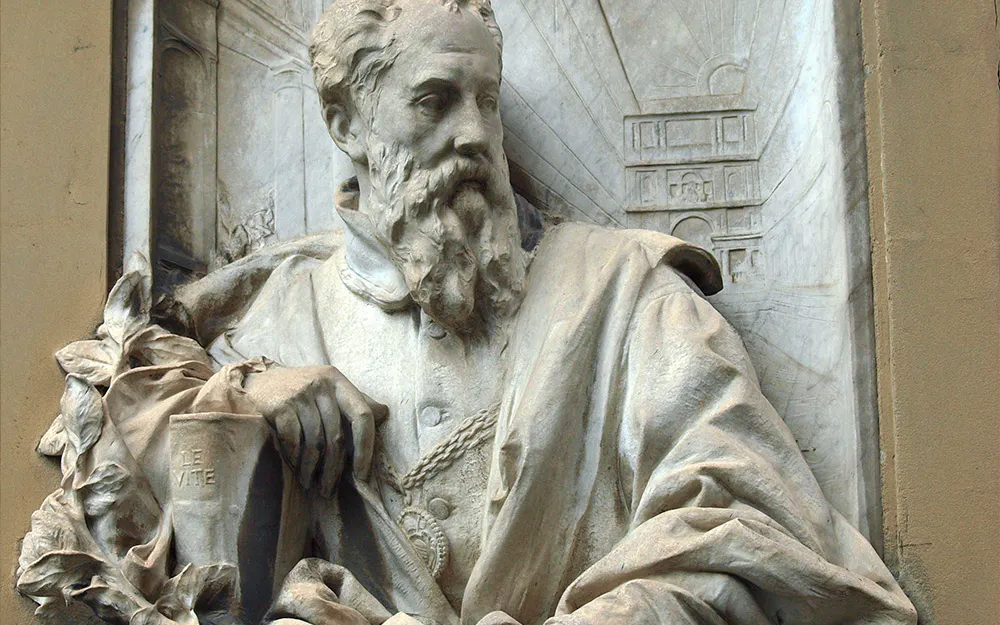
5 Private rooms of Medici
The second floor features the highly ornamented private rooms of the Cosimo de' Medici. The private rooms include apartments, small chambers, and a private chapel.
Apartments of the Elements
The Room of Elements takes the spotlight, with the walls filled with frescoes with metaphors of Water, Fire, and Earth. The room is also decorated with mythological paintings created by Giorgio Vasari and his apprentices.
The Terrace of Saturn or the Loggiato di Saturno features a fresco on the ceiling metaphorically representing Saturn. The room offers a fabulous view of Florence, including the Piazzale Michelangelo and the Fortress Belvedere.
Apartments of Eleonora of Toledo
The Apartments of Eleanora di Toledo, the living quarters of Cosimo’s wife Eleanora. The apartment includes her own chapel, with frescos including The Deposition of Christ, painted by Renaissance artist Bronzino.

Plan Your Visit
Getting to Palazzo Vecchio
By Bus
The following bus lines have routes stop at Piazza della Signoria (1 min walk away from Palazzo Vechhio) - C1, C2, or D , depending on the direction you come from.
By Subway
The closest subway station is the Unita. It is isat a 15-minute walk to the Palace.
By Car
Type P.za della Signoria, 50122 Firenze FI, Italy on your smartphone/GPS app and follow the directions.
Best Time To Visit Palazzo Vecchio
- Spring is the ideal season to visit Florence, that would be from March to May.
- The best time to visit Palazzo Vecchio is during the early opening hours at 9 am to avoid crowds.
Insider Tips
- Try to avoid visiting on weekends, since that’s when most places including the Palace are packed.
- Read up on the Medici Empire, so the trip will be more fun and interesting.
- Keep your phone on silent and turn off notifications before entering the Palace for a distraction-free experience.
- Get tickets in advance to skip the lines and not tire yourself out.
- Get the audio guide in advance, and read the inscriptions and booklets on the exhibits to make the experience enriching.
- Do not forget to bring in your earphones to use the audio guide.
- Carry a backpack while roaming around, as it comes in handy to store the souvenirs or booklets you may buy.
- Wear comfy clothes and shoes, since you have to walk around inside and stay focused on the experience rather than that tacky clothing.
- Eat your meal before entering the Palace, since it would typically take 1 to 2 hours before you get out.
Things To Do Near Palazzo Vecchio
Here are some top attractions which are located near Palazzo Vecchio that you should add to your itinerary.
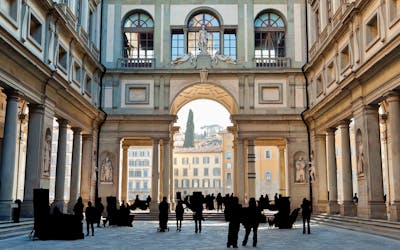
The Uffizi Gallery is one of the most famous art museums in the world, and it is certainly worth a visit if you are ever in Florence, Italy. The Uffizi is renowned for its collection of Renaissance art, which includes masterpieces by artists such as Leonardo da Vinci, Botticelli, and Michelangelo.
Even if you are not an art lover, the Uffizi is worth a visit for its sheer beauty and historic importance.
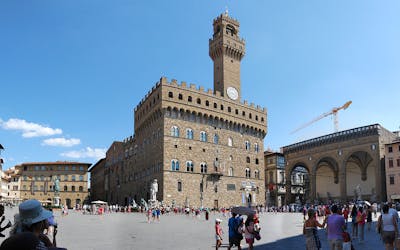
Piazza della Signoria is one of the most iconic squares in Florence, Italy. It is home to several important structures, including the Palazzo Vecchio, the Loggia dei Lanzi, and the Fountain of Neptune. The square has a long history dating back to Roman times, and it has been the site of many important events over the centuries. Today, it is a popular gathering place for locals and tourists alike.
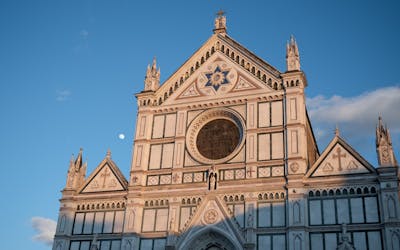
The Santa Croce was built in the 13th century. It is the final resting place of some of the most famous Italian people like Michelangelo, Galileo, and Machiavelli. The interior of the church is very ornate with paintings and sculptures. The exterior is made of red brick and has a green copper roof. Santa Croce is a beautiful church that is definitely worth seeing when you visit the Palazzo Vecchio.
Restaurants Near Palazzo Vecchio
Here are the top three places to eat nearby, all within a 3 minute's walk from the Palazzo Vecchio.

This pizzeria is a local favorite, known for its delicious Italian cuisine. Guests often rave about the Neapolitan pizza and the sandwiches here.The staff is always attentive and helpful, so you're sure to have a great experience. They offer great portions at great prices, with vegeterian options readily available.
Find on Map >
If you're looking for a hearty sandwich in Florence, then look no further than I' Girone De' Ghiotti! They offer affordable sandwiches packed with meat and cheese, along with beer and wine. The perfect spot for a quick lunch or an evening bite, I' Girone De' Ghiotti offers something for everyone. They offer vegan options too and are popular among customers.
Find on Map >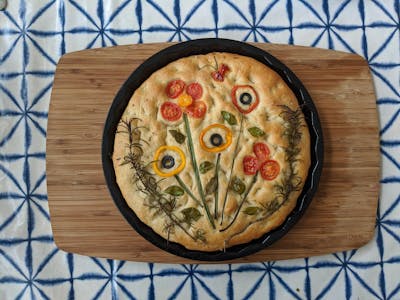
Gustarium is a great spot for those who want to try a little bit of everything. Their focaccia-style pizza is sold by weight, so you can get as much or as little as you want. Offering cooked salmon pizza, prosciutto, mozzarella, and more, there's something for everyone to enjoy. The atmosphere is casual and relaxed, making it the perfect place to gather with friends and family.
Find on Map >Frequently Asked Questions
Where is the Palazzo Vecchio?
When was Palazzo Vecchio built?
What is there to see in Palazzo Vecchio?
How can I buy Palazzo Vecchio tickets?
Is Palazzo Vecchio accessible by visitors with limited mobility?
What are the safety precautions taken at Palazzo Vecchio?
Other top experiences in Florence
If you're planning a visit to Florence, there's no shortage of things to see and do. In addition to the world-famous art and architecture, the city is home to a number of other great attractions. Here are just a few of the many sights that are now open to the public, check out more things to do in Florence.


